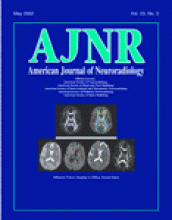Abstract
Summary: This is a case report of unusual case of choroid plexus cyst at the right foramen of Monro in the anterior third ventricle that caused unilateral obstructive hydrocephalus. The value of small-FOV thin-section MR imaging in the diagnosis of small lesions of the foramen of Monroe is demonstrated. The immunohistochemical findings in choroid epithelial cysts in comparison with those of other types of cysts at this location are discussed.
Choroid plexus cyst in the anterior third ventricle is a relatively common finding at autopsy, but the cyst is usually asymptomatic. To our knowledge, only seven symptomatic choroid cysts were reported between 1956 and 1984, and none were located at the foramen of Monroe (1).
Case Report
A 53-year-old woman presented with recurrent headaches since 1998 as well as multiple falls without loss of consciousness. CT and MR imaging of the brain at an outside institution revealed only asymmetry of the lateral ventricles, with enlargement of the right lateral ventricle. The patient came to our institution for further workup. Repeat T1- (5000/12/5 [TR/TE/NEX]) and T2-weighted (5000/128/5) MR imaging was performed with a modified protocol that included a small FOV (16 × 16 cm) and thin-section (3-mm) MR imaging at the level of foramen of Monroe. The images revealed a small cystic lesion at the right foramen with a signal intensity similar to that of CSF that produces unilateral right-sided hydrocephalus (Figs 1–3).
Axial MR images demonstrate unilateral right-sided hydrocephalus with deviation of the septum pellucidum to the left.
A, T1-weighted contrast-enhanced image.
B, T2-weighted image.
Coronal MR images demonstrate a 5-mm cystic lesion (arrow) with CSF-like signal intensity.
A, T1-weighted contrast-enhanced image.
B, T2-weighted image. The signal intensity of the lesion is slightly higher than that of CSF and is likely to be related to the to the higher protein content of the cyst compared with that of the CSF.
Sagittal MR images demonstrate a 5-mm nonenhancing cystic lesion (arrow) at the right foramen of Monro.
A, T1-weighted contrast-enhanced image.
B, T2-weighted image.
Surgery
The patient underwent resection of anterior third ventricular cyst via a right transcallosal approach with the use of a Surgiscope DeeMed, Grenoble, France and intraoperative sonography (Figs 4, 5).
Intraoperative image reveals a cystic lesion (straight arrow) at the right Foramen of Monro. The curved yellow arrow indicates the normal choroid plexus exiting the lateral ventricle through the foramen of Monro; curved white arrow, the septal vein.
The lesion is completely resected, and the foramen of Monro is open.
Pathology
The surgical specimen consisted of a smooth thin-walled cyst that measured 5 mm and contained CSF-like fluid. Histopathologic study revealed a fibrous vascular stroma covered by cuboidal epithelium. The appearance was that of choroid plexus neuroepithelial cells. Findings with immunohistochemical staining were confirmatory, with a positive reaction for transthyretin and negative reactions for epithelial membrane antigen (EMA) and mucin (mucicarmine). Other considerations eliminated as diagnostic possibilities included colloid cyst (negative mucin result) and arachnoid cyst (negative EMA result).
Follow-up
The patient had an uncomplicated postoperative course, with symptomatic relief.
Discussion
Choroid plexus cysts can occur throughout the ventricular system, but they are most frequently present in the glomus of the lateral ventricles. They are usually more common in children than in adults (2). These cysts arise from the primitive neuroepithelium. They contain CSF, and their wall is composed of connective tissue interspersed with epithelial cells. The typical choroid plexus cyst has low signal intensity on T1-weighted MR images and high signal intensity on T2-weighted MR images. In some cases, T2-weighted images may show that the cysts have higher signal intensity than that of CSF (Figs 2B, 3B). This finding is attributed to higher protein content of the cyst compared with that of the CSF (2).
The differential diagnosis of a cyst in the anterior third ventricle includes a colloid cyst, ependymal cyst, arachnoid cyst, Rathke cyst, cystosercosis, and histocytosis X (3). Immunohistochemical studies are useful in differentiating between these different types of cysts. The epithelium of choroid and ependymal cysts shows immunoreactivity for markers of normal neuroepithelial structures of the CNS. Choroid plexus epithelium has positive results with transthyretin, and ependymal epithelium has positive result with glial fibrillary acidic protein. On the contrary, the epithelial wall of colloid cysts and Rathke cleft cysts express epithelial markers, such as mucin (mucicarmine) (Fig 6). These markers support the theory of a neuroepithelial origin of a choroid plexus cyst or ependymal cyst and n endodermal origin of a colloid cyst or Rathke cleft cyst (4, 5).
Flowchart shows the immunohistochemical findings in different anterior third ventricle cysts. +ve indicates a positive finding.
Conclusion
Conventional MR images of small lesions in the foramen of Monroe may not show the lesion but only their secondary effect, namely, hydrocephalus. If a focused high-resolution (thin-section small-FOV) MR imaging technique is used, diagnosis is possible, and the findings aid in surgical planning.
Footnotes
Presented at the ASNR meeting in Boston, MA, 2001.
- Received November 21, 2001.
- Accepted after revision November 12, 2001.
- Copyright © American Society of Neuroradiology













